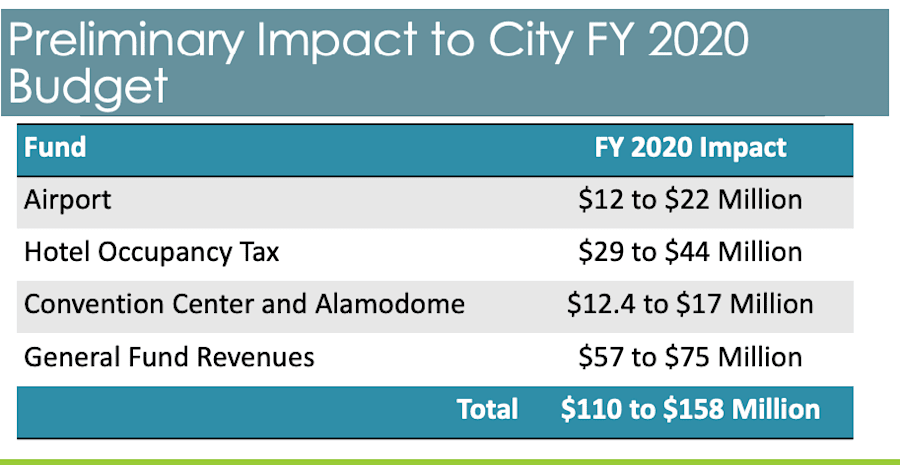SAN ANTONIO – CLARIFICATION: An earlier version of this article included an incorrect unemployment rate statistic that was based on an inaccurate city presentation. Additionally, the earlier version incorrectly ascribed the unemployment rate projections only to San Antonio, instead of the entire metropolitan area. Both issues have been clarified below.
Dramatic decreases in airport traffic, sales tax revenue, and rapidly climbing unemployment are already appearing as the COVID-19 pandemic continues to unfurl in San Antonio.
In a presentation to city council members on Thursday, top city staff presented the latest figures and projections related to the pandemic. The information was discussed before the council unanimously voted to formally extend the mayor’s “Stay Home, Work Safe” order to April 9.
San Antonio is facing a projected unemployment rate of 12-14 percent for March, Deputy City Manager Maria Villagomez said. That projection would far surpass the 7.7 percent unemployment rate the San Antonio-New Braunfels Metropolitan Statistical Area faced in Nov. 2010 following the Great Recession, according to data from the Federal Reserve Bank of Dallas.
The economist who created the projection, Steve Nivin, later clarified to KSAT that the March projection also pertained to the entire metro area, not just the city of San Antonio.
Meanwhile, Villagomez said the city could be looking at a $110 million to $158 million hole in its operating budget for this fiscal year, with a decrease in several key revenues. The city’s budget for this fiscal year, which lasts through September, totals about $2 billion.
Traffic at San Antonio International Airport was down 90 percent on Tuesday, Villagomez said, and many hotels have closed amid reports of occupancy rates under 10 percent. More than a dozen events at the Convention Center and Alamodome have been canceled or postponed, and officials are anticipating a 17 percent decrease in sales tax revenue.

The vote to extend the mayor’s order was essentially a formality, with April 9 already having been the date noted in the order, “subject to San Antonio City Council approval.” Though without that approval, the mayor’s order, which took effect Wednesday, would only have been in effect for a week.
The “Stay Home, Work Safe” orders from the city and county require residents to stay at home unless they are performing “exempted activities” or working at an “exempted business.” All other businesses are supposed to shut down.
Previous orders from the mayor and Gov. Greg Abbott had already closed bars and reduced restaurants to just takeaway, delivery, and drive-thru service.
Speaking to reporters after the meeting, Nirenberg said he understood people’s lives had been turned upside down.
“That’s why these issues are so difficult, and the decisions that we make are difficult and have tremendous weight behind them. We don’t take them lightly," he said. “We are with you, and we are going to help you get back on your feet. But the most important thing we can do together right now is to make sure that we save each other’s lives. That’s why we’re doing this.”
City officials don’t know when they’ll be done responding to the pandemic and can focus on recovering from it. A former football player, City Manager Erik Walsh said the city still doesn’t know what quarter the game is in, “and there still isn’t a playbook.”
Walsh also said there’s “no answer” whether the jobs that have disappeared will return.
“I think everybody is struggling with that. You know, the recovery could bounce back - I’ve seen projections over a couple of months or 18 months. It’s the unknown, and that’s what we’re all dealing with," he said.
COVID-19, the respiratory disease caused by the new virus, stands for coronavirus disease 2019. The disease first appeared in late 2019 in Wuhan, China, but spread around the world in early 2020, causing the World Health Organization to declare a pandemic in March.
MORE CORONAVIRUS COVERAGE FROM KSAT:



